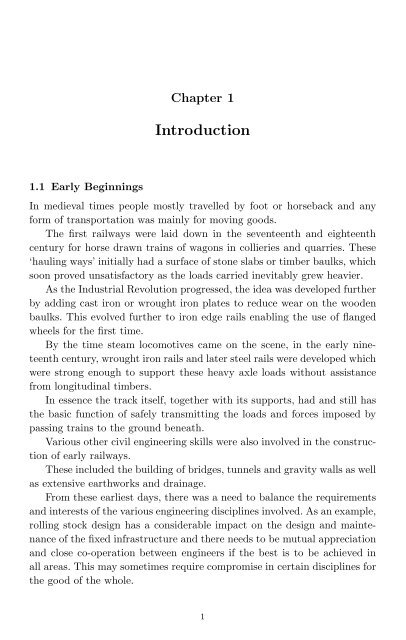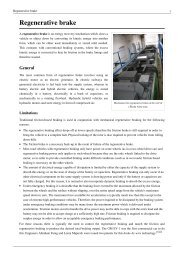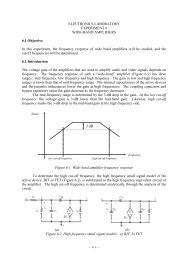2nd Edition
2nd Edition
2nd Edition
Create successful ePaper yourself
Turn your PDF publications into a flip-book with our unique Google optimized e-Paper software.
Chapter 1<br />
Introduction<br />
1.1 Early Beginnings<br />
In medieval times people mostly travelled by foot or horseback and any<br />
form of transportation was mainly for moving goods.<br />
The first railways were laid down in the seventeenth and eighteenth<br />
century for horse drawn trains of wagons in collieries and quarries. These<br />
‘hauling ways’ initially had a surface of stone slabs or timber baulks, which<br />
soon proved unsatisfactory as the loads carried inevitably grew heavier.<br />
As the Industrial Revolution progressed, the idea was developed further<br />
by adding cast iron or wrought iron plates to reduce wear on the wooden<br />
baulks. This evolved further to iron edge rails enabling the use of flanged<br />
wheels for the first time.<br />
By the time steam locomotives came on the scene, in the early nineteenth<br />
century, wrought iron rails and later steel rails were developed which<br />
were strong enough to support these heavy axle loads without assistance<br />
from longitudinal timbers.<br />
In essence the track itself, together with its supports, had and still has<br />
the basic function of safely transmitting the loads and forces imposed by<br />
passing trains to the ground beneath.<br />
Various other civil engineering skills were also involved in the construction<br />
of early railways.<br />
These included the building of bridges, tunnels and gravity walls as well<br />
as extensive earthworks and drainage.<br />
From these earliest days, there was a need to balance the requirements<br />
and interests of the various engineering disciplines involved. As an example,<br />
rolling stock design has a considerable impact on the design and maintenance<br />
of the fixed infrastructure and there needs to be mutual appreciation<br />
and close co-operation between engineers if the best is to be achieved in<br />
all areas. This may sometimes require compromise in certain disciplines for<br />
the good of the whole.<br />
1

















